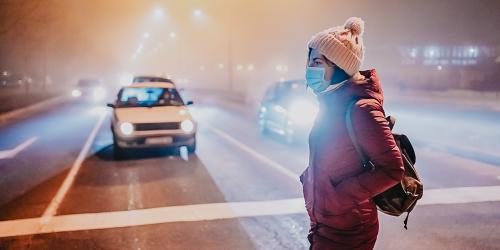As winter settles in drivers contend with poor visibility and challenging driving conditions and pedestrian safety becomes a primary concern, especially for children and the elderly.
The heightened danger to child pedestrians results because they[i]:
- are generally harder for drivers to see
- may not understand how to cross the road safely
- may have difficulty reacting to traffic (determining the direction of sound or judging distance or speed of oncoming vehicles)
- cannot see out of the corners of their eyes as well as adults
- may not realize that drivers are paying attention to other things, and not just them
- may not understand that vehicles take longer to stop on wet or snowy roads
For older adults there may also be issues with hearing and sight as well as mobility challenges when crossing a roadway.
The RCMP reports that in 2020 there were 192 pedestrians involved in collisions in Alberta. Sixteen of these pedestrian collisions resulted in fatalities.
Compensation for Pedestrian Injuries
It’s clear that there is a greater risk of serious injuries in a collision between a car and a pedestrian compared to a similar collision involving two vehicles. Determining compensation for injuries to pedestrians is guided by the same principles as injuries sustained in collisions between vehicles. Determining the issue of liability for the incident also applies similar principles, but there are some special considerations that are specific to vehicle / pedestrian collisions.
Assuming a Court finds liability on the part of the driver for the collision, the Court will then look at the actions of the pedestrian to determine if there was something that they did or didn’t do to take care for their own safety that contributed to the collision. If such contributory negligence is found, the pedestrian’s compensation will be reduced by a percentage amount based on the comparative blameworthiness of the driver of the vehicle and the pedestrian as assessed by the Court.
Courts have found pedestrians blameworthy for such factors as failing to cross at crosswalks, walking while intoxicated, wearing dark clothing that makes it hard for drivers to see them, wearing clothing (like hoodies) that obscure peripheral vision, walking while distracted, and rushing out into traffic without confirming that motorists have seen them and are yielding the right of way to them.
Who is At-Fault in Accidents Involving Pedestrians?
In Alberta, the onus of disproving negligence where a vehicle and a pedestrian collide, is on the driver of the vehicle (Traffic Safety Act s. 186). This means that contrary to normal circumstances where an injured party must prove negligence on the part of the wrongdoer, there is a presumption by the Court that the driver is at fault unless the driver can show that the pedestrian’s loss or damage did not entirely or solely arise through the negligence or improper conduct of the owner or driver of the vehicle.
Pedestrian Responsibilities
While the onus of disproving negligence is on drivers, that does not mean that pedestrians have no legal duties. As a pedestrian you do have a legal duty to take care for your own safety. That duty is described in the Alberta Traffic Safety Act, RSA 2000, c T-6, Use of Highway and Rules of Road Regulation, Alta Reg. 304/2002, which says that a pedestrian shall:
- use a sidewalk or path beside a roadway when reasonable and practicable
- when a sidewalk or path is not available, proceed on the left side of the roadway or the shoulder of the highway, facing traffic
- cross a roadway as quickly as is reasonable
- not stop or loiter while crossing the highway or a roadway or otherwise impede the movement of the vehicles on the highway
- not proceed into the path of a vehicle such that it is impracticable for the driver of the vehicle to stop
- if crossing in a place other than a crosswalk, yield the right of way to the vehicles on the roadway
- if crossing in a crosswalk, nonetheless “exercise due care for their own safety”
Evidence of a pedestrian’s failure to fulfill these duties may well have an impact on the amount of compensation recovered when an accident occurs and injuries result.
Continuum of Pedestrian Recovery – What the Cases have Said
The case law reflects a continuum of potential recovery for pedestrians. For example, on one end of the continuum we have the case in G.(I.) (Next Friend of) v. Harmon, 1999 ABQB 354. In this case, a 7-year-old boy was walking from Rideau Park School in southwest Calgary to the Glencoe Club when he was hit by a truck driven by the defendant. The boy was severely injured. Before crossing the street, the boy stopped to press the button to activate flashing lights and then entered the crosswalk. But he did not ensure that all of the cars had come to a stop. The 63-year-old driver had significant vision problems with his right eye due to an industrial accident years before, and his vision was blurred. He had no memory of seeing the crosswalk lights flashing or the stationary vehicles yielding to pedestrians. The defendant was found to have “failed to see what was there to be seen” and was held 100% liable for the boy’s injuries. In dismissing the allegations of contributory negligence of the young pedestrian, the judge said:
A seven-year-old is still innocent enough to believe that drivers will obey the rules; that drivers will observe flashing pedestrian lights; that drivers will not pass stationary vehicles in front of crosswalks. A seven-year-old child is still innocent enough to believe what he has been told — that a crosswalk is a place to safely cross the street. A child has not learned the harsh reality that on major urban streets there are no true places of safety for pedestrians — where safety can be assumed. That knowledge comes from a lifetime of experience of close calls and near misses.
Towards the other end of the continuum is the case of Cooper v. Crockford, 2007 ABQB 411. In this case, an adult pedestrian was hit while attempting to cross a busy roadway. This pedestrian was intoxicated did not cross at a crosswalk but rather jaywalked, and he was wearing dark clothing, making him hard to see. In addition, he was oblivious to emergency lights and the wailing siren of an ambulance responding to a call and he walked right into the side of an ambulance. The pedestrian was held to be the primary cause of the accident, even though the court determined that the ambulance could have easily avoided the accident. The plaintiff pedestrian was held to be 2/3 liable, and the defendant 1/3.
Liability for a collision with a pedestrian can also occur in situations that we don’t usually think of. For example, when a person has been in a motor vehicle accident, and then, dazed and in trauma, the accident victim, now a pedestrian, seeks help from another motorist and puts themselves in harm’s way. This was the situation in Chan v. Insurance Corp. of British Columbia, 2000 BCSC 1229. Here the plaintiff Chan was struck while driving home from work by an unidentified motorist driving the wrong way on a one-way street. As a result of this accident, Chan was in emotional shock. She saw a person on the side of the street, got out of her vehicle, and ran across a crosswalk marked “Don’t Walk” towards that person for help. Unfortunately, she was hit by a truck and injured. ICBC, as the representative of the unidentified motorist, was held to be entirely liable for her damages from the first accident and two-thirds liable for her damages from the second accident. The defendant truck driver was held responsible for the remaining third of the damages from the second accident.
Rules and Responsibilities for Pedestrians and Drivers
Basic safety tips recommended for pedestrian safety are illustrated by these tips from the Parachute organization here.
We have also covered the basic duties of drivers and pedestrians in our earlier post: Drivers and Pedestrians. Do You Follow the Rules of the Road?
In short, compensation for pedestrian injuries depends on the facts in your case. That is why it’s important to speak to a personal injury lawyer with experience dealing with pedestrian injuries. They will evaluate your case quickly and determine the evidence needed to prove your claim and tell you what to expect.
About CAM LLP experienced personal injury lawyers
At CAM LLP, we understand the impact and ripple effects that a serious injury can have on your life and the lives of those you love.
Since 1962, our lawyers have achieved precedent-setting results for injured Albertans, including pedestrians injured in collisions with motor vehicles.
Years of experience evaluating claims, negotiating settlements with insurance companies, and helping injured people get fair compensation makes a difference.
Please contact us for a free consultation.
[i] City of Toronto at <<Pedestrian Safety – City of Toronto>>

